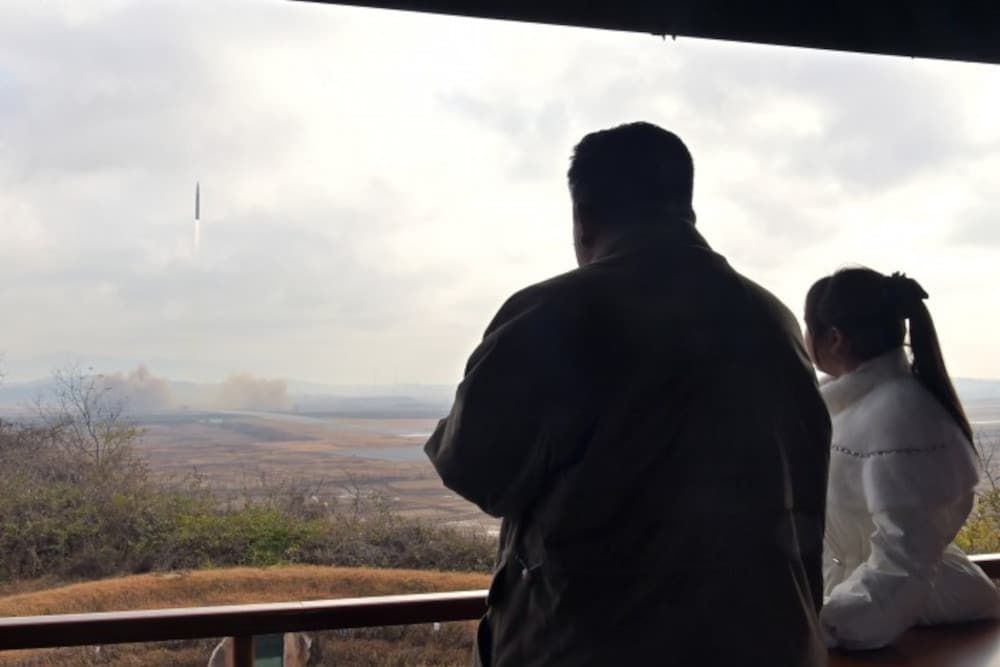As North Korea readies for a nuclear test, does it have a new doctrine?
By Hyun-Binn Cho, Ariel Petrovics | November 21, 2022
 North Korea's leader Kim Jong-un oversees a missile launch with his daughter at Pyongyang International Airport in Pyongyang, North Korea on November 18, 2022. (Photo released by North Korea's Korean Central News Agency - KCNA).
North Korea's leader Kim Jong-un oversees a missile launch with his daughter at Pyongyang International Airport in Pyongyang, North Korea on November 18, 2022. (Photo released by North Korea's Korean Central News Agency - KCNA).
In September, North Korea passed new legislation that marks the most significant update to its nuclear doctrine in a decade. This milestone document outlines 11 articles describing the regime’s “nuclear weapons policy,” including the conditions under which Pyongyang would launch nuclear weapons. Since the legislation was passed, analysts have been pondering its implications for North Korea’s nuclear strategy and how it fits with recent missile tests or the regime’s expected seventh nuclear test. Even though news reports on North Korea’s new nuclear doctrine have highlighted the regime’s willingness to launch nuclear weapons preemptively, the most important update from the legislation is North Korea’s novel articulation of its nuclear command and control system or, in other words, its nuclear decision-making process. The legislation and recent developments together indicate that Pyongyang is moving toward a more coherent first-use nuclear strategy.
North Korea is already on record for issuing threats of preemptive nuclear attacks, but other indicators of the Hermit Kingdom’s nuclear strategy have been contradictory. For example, its command-and-control system and its lack of field-deployed tactical nuclear weapons have both undermined Pyongyang’s statements. These misaligned indicators created uncertainty that led experts to disagree over what strategy North Korea is pursuing, particularly since 2017, when the regime tested multiple short- to long-range ballistic missiles and conducted its sixth nuclear test during the “fire and fury” crisis with the United States. The September 2022 legislation, however, moves North Korea more squarely toward a first-use nuclear strategy, which aims to deter aggression by threatening to asymmetrically escalate to a nuclear strike before its adversaries in a crisis or conventional conflict.
Regional power nuclear strategies have traditionally been distinguished from the nuclear strategies of the two superpowers—Russia/Soviet Union and the United States. Political scientist Vipin Narang, for example, identifies three regional power nuclear strategies. One strategy is based on a first-use approach that threatens to launch nuclear weapons before its adversaries to deter aggression (e.g., present-day Pakistan). This deterrent strategy can include threats of preempting an imminent conventional or nuclear attack. In contrast, a deterrent strategy based on a second-strike approach aims to deter nuclear aggression by promising a nuclear strike in retaliation (e.g., China and India). And a third strategy aims to deter aggression by threatening nuclear breakout and catalyzing a nuclear patron to intervene (e.g., early Pakistan). Determining what nuclear strategy, if any, a regional power may be pursuing involves making a comprehensive assessment of its official statements, discernible technological capabilities, and broader security priorities to ascertain the manner and conditions under which a country primarily envisions using its nuclear weapons.
In terms of official statements, North Korea has issued multiple threats of nuclear preemption in the past. For example, in 2016, a spokesperson for the Korean People’s Army General Staff Department stated that “at the slightest indication that there is an attack, [North Korea] will relentlessly conduct a nuclear preemptive strike [hek sunje tagyuk] in our own way.” In April 2022, the regime implied that it would use nuclear weapons if enemies “try to violate the fundamental interests of [the North Korean] state.” These threats and others suggest that Pyongyang would be willing to fire nuclear weapons on adversaries if it believes it faces an immediate conventional or nuclear threat.
Despite North Korea’s threats of nuclear preemption, however, other indicators have not aligned with a strategy of first use, dividing experts about the country’s nuclear strategy. Principal among these indicators is a state’s nuclear command-and-control system. Through major legislation passed in 2013, North Korea expressed a centralized (or “assertive”) command and control system by stating that its then-relatively new leader Kim Jong-un has the sole authority to launch nuclear weapons. But, as experts have noted, an assertive decision-making system slows down the launch of nuclear weapons because the authorization must travel down the chain of command. This system has undermined not only North Korea’s threats of nuclear preemption but the characterization that Pyongyang is pursuing a first-use nuclear strategy.
The new legislation passed in September includes a section on the “command and control of nuclear forces,” which revises North Korea’s nuclear command-and-control system. This section stipulates that the regime is prepared to launch nuclear weapons “immediately and automatically” with “plans that have already been made” if its “nuclear command and control system comes under danger from attack by enemy forces.” Rather than await direct orders from Kim Jong-un, field commanders may now follow predetermined launch plans to release nuclear weapons. The language in the legislation, moreover, leaves open the possibility that the regime could launch nuclear weapons using predetermined plans even before its enemies conduct a nuclear or conventional attack. By passing legislation that includes a more decentralized (or “delegative”) command-and-control system, North Korea appears to provide greater coherence to a nuclear strategy of first use.
This critical development is often overlooked by observers, but it provides at least two important benefits to Pyongyang. First, it increases the credibility of its threats of nuclear preemption by aligning existing statements with a corresponding command-and-control system. This delegative system increases the credibility of threats to use nuclear weapons first by both reducing nuclear launch time and enabling North Korea to fire nuclear weapons before its adversaries if theater commanders lose communication with Pyongyang, such as after an attempted conventional decapitation strike against the regime’s leadership. This is not to say that North Korea would necessarily succeed at launching a nuclear first strike. For example, the United States possesses preventive and preemptive capabilities that can cripple North Korea’s nuclear weapons before they are fired. But the new legislation takes specific steps to move Kim’s regime away from bluster and “cheap talk” and toward a more credible first-use strategy.
Second, by articulating a more coherent nuclear strategy North Korea demonstrates maturity in its nuclear thinking, which may boost the regime’s profile as a nuclear-armed state. The new legislation adopts markedly assertive language about North Korea’s nuclear status, declaring that the regime will “never abandon” nuclear weapons. Some experts claim that North Korea strives for international recognition as a nuclear weapons state like India or Pakistan. For years, the misalignment between North Korea’s statements, capabilities, and command-and-control system generated uncertainty about its nuclear strategy, whereas other regional nuclear powers have nuclear strategies that more readily fit traditional categories. By aligning its command-and-control system with a traditional first-use strategy, North Korea may seek to join the ranks of more established regional nuclear powers.
Even though North Korea’s new legislation clarifies its nuclear strategy, it is not obvious why the regime decided to update its nuclear command-and-control system now. One reason may be Kim’s maturity as a leader. While the new, more decentralized system enhances the credibility of a first-use strategy by increasing the chances of successfully releasing nuclear weapons, it also risks empowering potential domestic rivals with authority they could redirect to challenge Kim’s leadership. It is worthwhile noting that the 2013 legislation mentioned above was passed only a few years after Kim Jong-un came into power. In this regard, the recent update to North Korea’s nuclear strategy may reflect Kim’s increasing confidence as a ruler rather than the achievement of a technological breakthrough.
Beyond the new legislation, there are important developments to watch for that could further clarify North Korea’s nuclear strategy. In particular, fielding smaller “tactical” nuclear weapons that can be used rapidly on the battlefield would corroborate the legislative evidence that the regime is adopting a first-use nuclear strategy.
Unlike larger, strategic nuclear weapons, tactical nuclear weapons may provide a more moderate escalation option to the nuclear level that can reduce the risk of inviting devastating retaliation that jeopardizes the regime. This possibility makes tactical nuclear weapons a key indicator of a first-use deterrent strategy for regional nuclear powers. For example, Pakistan showcases its large arsenal of low-yield warheads as part of its “full spectrum” deterrent strategy of first use against India. As for North Korea, because the survival of its retaliatory nuclear capabilities is still in doubt, it must be especially wary of risking a massive retaliatory blow from its adversaries following nuclear first-use. In this light, Pyongyang could bolster the credibility of a first-use strategy by fielding tactical nuclear weapons too.
But for this North Korea would need to overcome technological hurdles to operationalize a robust nuclear command-and-control system that can support battlefield-ready tactical nuclear weapons as part of a reliable first-use strategy. These challenges include minimizing the risk of unauthorized launches, ensuring nuclear weapons are released when a launch is authorized, and launching before adversaries can neutralize such efforts. Its new delegative system, however, can be considered a step toward potentially deploying tactical nuclear weapons.
In recent weeks, North Korea has taken additional steps to fill capability gaps by testing ballistic missiles that could be mounted with tactical warheads and claiming that its soldiers have simulated the loading of “tactical nuclear warheads at a silo under a reservoir.” It followed such steps with new intercontinental ballistic missile (ICBM) tests that suggest the regime is also working to deter large-scale retaliation after a nuclear first use by enhancing the threat of nuclear reprisal on the United States. Taken together, these indicators suggest that Kim’s regime is making demonstrative efforts toward a more coherent first-use nuclear strategy. As such, it is particularly important to keep an eye on North Korea’s new developments – including if the regime’s anticipated seventh nuclear test involves a low-yield device.
Understanding what the recent flurry of events means for North Korea’s nuclear strategy remains critically important as indicators like its nuclear capabilities and command-and-control system continue to evolve. Even though uncertainty remains as to when and how the reclusive regime plans to use its nuclear arsenal, the new legislation offers an important glimpse into North Korea’s evolving nuclear strategy.
Together, we make the world safer.
The Bulletin elevates expert voices above the noise. But as an independent nonprofit organization, our operations depend on the support of readers like you. Help us continue to deliver quality journalism that holds leaders accountable. Your support of our work at any level is important. In return, we promise our coverage will be understandable, influential, vigilant, solution-oriented, and fair-minded. Together we can make a difference.















